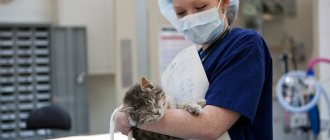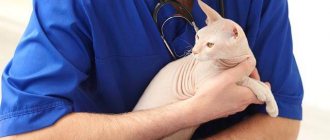8221Administration
For owners of adult cats during their sexual heat, problems such as marking their territory, aggressiveness of the pet, and preventing the appearance of unwanted offspring become relevant.
There are two main ways to solve them:
- temporary suppression of sexual desire with hormonal drugs;
- surgical castration.
Since long-term use of hormones significantly increases the risk of various complications, including cancer, veterinarians advise opting for castration. This procedure, if prepared in advance, is not hazardous to health , does not reduce the hunting instinct and playfulness of the animal, it will no longer develop testicular cancer and the likelihood of developing a prostate tumor will be reduced. Owners who have decided to undergo surgery are faced with the question of how to prepare their cat for castration.
When is the operation performed?
The operation should be performed after the age of 9 months. However, in order not to encounter the typical behavior of a mature male, it is better to carry it out before puberty at 6 months.
Many shelters and nurseries practice early castration at 3 months, since by this age the kittens are already quite independent, they have received all the necessary vaccinations.
Early castration of animals slows down their growth and development, but this does not have global consequences; growth will still continue according to the genetically programmed program. In the case of partial castration with leaving the appendages of the connective tissue base of the testes (vasectomy or sterilization), the hormonal function of the gonads is not disrupted , which contributes to better growth of the animal, but all problems, except for unwanted reproduction, remain.
© shutterstock
The age limit for castration is limited only by the pet’s health condition and the ability of its body to tolerate anesthesia; if a preliminary examination does not reveal any contraindications, then the operation can be carried out after preliminary preparation.
It does not matter for castration of a cat whether he has already mated or not yet.
Deworming and vaccination
The first vaccinations for cats are given at the age of two months. Further vaccinations are carried out according to the schedule recommended by the veterinarian. As a rule, if the animal does not have serious health problems, by 7-8 months the basic vaccinations have already been completed. At the time of surgery, at least a month must have passed since the last vaccination; this will reduce possible risks.
If for some reason the cat has not been vaccinated, then the veterinarian may suggest administering a special serum that promotes the rapid formation of immune defense against infections.
Also, before the operation, the cat should be given a course of anthelmintic drugs to be sure that the animal is not infected with parasites. Veterinarians recommend this therapy be carried out regularly, at least once every six months. If no more than a month has passed since the last anthelmintic course, then unscheduled deworming may not be carried out.
Before taking your pet to the clinic for surgery, you must also carry out treatment against ectoparasites (external). For this purpose, special shampoos, emulsions or sprays are used. It is better to bathe with antiparasitic shampoo 7-10 days before visiting the doctor.
For most cats, washing is a serious stress, as is a trip to the veterinarian, so it is advisable to separate these events a little in time so as not to greatly emotionally traumatize the animal.
However, today many veterinary clinics offer the service of visiting a doctor at home. Castration can also be performed at home, since this operation does not present much difficulty for an experienced doctor.
What is castration
For females, castration is a more complex abdominal operation to remove the gonads than for males. Owners often confuse and replace the concept of castration with the term sterilization in relation to cats, although in veterinary medicine, sterilization of a cat is associated only with the deprivation of the ability to produce offspring by ligating the oviducts, without removing the reproductive organs, however, in this case, if the cat is not prepared for the procedure, there is a high risk of polycystic disease ovaries and inflammation in the uterus.
Correctly, the operation to remove the ovaries and uterus is called ovariohysterectomy; this is the best option for the prevention of all kinds of gynecological diseases.
When it comes to removing only the ovaries, an oophorectomy is performed. It is better for the cat owner to understand these terms in order to speak the same language with the doctor and get the desired result from the operation.
Preoperative fasting
Due to the fact that cat castration surgery involves general anesthesia, the owner should deprive the cats of food for the last 12 hours. It should be recalled that for carnivores, which include all cats, fasting for 1-2 days is normal and does not harm their health.
Fasting concerns only food, there is no need to exclude water. The reasons for “forbidden” and why you cannot feed the cat lie in the fact that vomiting may occur during the operation. If the animal's stomach is not empty, it may choke on its own vomit.
How to prepare a cat for surgery
Preparing a cat for castration does not contain a large list of activities.
- Firstly, as part of the preparation, it is necessary to carry out vaccination before castration and deworming, wait for the quarantine period, and check the general health of the cat with a veterinarian.
- You cannot feed a cat before castration. To prepare the body, it is necessary to fast a diet for at least 8 hours before surgery and abstain from drinking for 3-4 hours.
- The cat should be washed the day before castration.
General information
There are only two disadvantages to the operation:
- Castration is not reversible.
- If there are errors in diet and due to the characteristics of the breed, the cat may develop urolithiasis over time.
There are many more advantages to castrating a cat:
- The cat stops marking its territory.
- Problematic behavior during the rut becomes a thing of the past, as the rut no longer happens.
- The cat becomes more docile, aggression decreases.
- The risk of prostate cancer is reduced or completely eliminated.
- Castrated cats live 1.5-2 years longer than their uncastrated counterparts.
Carrying out the operation
After preparation, castration is performed through surgery under general anesthesia.
© shutterstock
The cat must be prepared for castration by a veterinarian. He administers anesthesia, removes hair from the animal's scrotum, treats the skin of the testicles with alcohol and then iodine. It’s good if the clinic has a separate anesthesiologist, this indicates a high level of the institution.
Through a small, 1-1.5 cm, incision in the scrotum, the testes are removed . The testes (or testes) are the paired sex glands of cats, in which, upon reaching puberty, sperm and the male sex hormone, testosterone, are formed. The spermatic cords extend from the testicles.
Removal of the testes occurs after the spermatic cord is twisted to prevent bleeding and a ligature of a special material is applied to it. Complete dissolution of the thread occurs spontaneously within three months. The wound is treated with a sterile cloth and a special spray containing antibiotics. The wounds on the scrotum are very small, so stitches may not be required; healing occurs very quickly. Their additional processing from the owner is not required.
Such an operation, including preparation, lasts up to half an hour, 15 minutes for anesthesia and about the same for surgery. The animal can be picked up immediately or left in the hospital to recover from anesthesia (for about three hours).
A common problem in cats is cryptorchidism, which is the failure of the testes (testicles) to descend into the scrotum. It can be one- or two-sided. Both the owner and the doctor must find out before the operation whether this pathology exists.
It is necessary to treat a cryptorchid cat by castration and removal of the testicle from the abdominal cavity or groin. At the same time, the second, healthy testis must be removed. At the same time, it is not permissible to remove a healthy testicle and leave the undescended one. Firstly, this may become a prerequisite for the development of testicular cancer, and secondly, behavioral deficiencies in the cat’s sexual heat will continue to bother the owners.
Usually the cat returns to normal life after surgery within 48 hours , complications are rare, and to minimize and prevent them, preliminary preparation, precision of the doctor’s hands and post-operative care are necessary. In case of a suspicious course of the postoperative period, namely prolonged weakness, drowsiness, lack of appetite, you should immediately contact a veterinary clinic.
© shutterstock
Positive and negative
From the owner’s point of view, the positive consequences of emasculation are the prevention or cessation of the pet’s sexual behavior. He will stop marking space, shouting, and attacks of aggression will stop.
The negative aspects of emasculating a cat is the risk of his death on the operating table due to intolerance to anesthesia. Your pet needs care on the day of castration. Therefore, you will have to take a one-day vacation. And finally, preparation for the operation and its implementation lead to additional costs. In addition, castrati need higher quality and more expensive food. But animal owners living in high-rise apartments have no other choice.
The cat marks the territory of the slipper
Preparation rules
If the animal is more than 5 years old, it may require consultation with a cardiologist.
The first thing an owner needs to do to prepare a cat for surgery is to go to a veterinary clinic. At the appointment, the veterinarian will prescribe tests that need to be taken and give recommendations on what can and cannot be done immediately before surgery. In addition, a specialist may prescribe a consultation with a veterinary cardiologist. A visit to this doctor is required to identify possible disorders in the activity of the cardiovascular system. Since castration is performed under general anesthesia, postoperative consequences cannot be ruled out after it. Owners of animals over 5 years of age will be required to visit a cardiologist.
Is it necessary to neuter a cat at all?
If you have the opportunity to find a female at the first demanding “meow!”, if you are already accustomed to the pungent smell of cat marks and torn wallpaper, if there are many kind hands around you who will happily sort out the offspring, or if you have a ruthless heart and You can drown kittens if the feeling of solidarity keeps you up at night. If you are not afraid that a domestic cat will find someone on the street to satisfy its basic instinct and contract some kind of feline gonorrhea from her, then, of course, you should not do this. You decide. But city life dictates its own conditions to cats, city conditions, which, by the way, are also cruel.
We recommend reading: How to properly care for a cat after castration?
Options for castrating a cat at home
| Budget | Standard | Optimal | VIP | |
| Calling a veterinarian to your home | ||||
| Castration | ||||
| Three-component European anesthesia | — | |||
| Recovery from anesthesia | — | — | ||
| IV | — | — | — | |
| Antiviral serum | — | — | — | |
| Promotion until the end of the month | 3200 rub. 2500 rub. | 4800 rub. 3500 rub. | 5800 rub. 4300 RUR | 8800 rub. 7300 rub. |
PS A dropper and the administration of hyperimmune serums completely normalizes the animal’s condition and protects it from infectious diseases within 2 weeks.
What to take with you to the examination
If a CT scan is performed for the first time, the patient needs to take with him a referral, passport and compulsory medical insurance policy. But if a person has previously undergone lung diagnostics, then it is necessary to show the doctor the results of past studies. It can be:
- X-ray;
- fluorogram;
- bronchoscopy results;
- discs with MRI or CT recordings.
Any available data can help diagnose the patient's condition. Therefore, even if only extracts from the medical record remain from the last examination, it is better to take them with you and show them to the doctor.
What tests are needed?
Sometimes your pet needs to donate blood for testing.
In some situations, preparing an animal for castration with vaccinations and deworming is not enough. During the examination, the veterinarian may prescribe additional examinations for the cat if there is a suspicion of the development of diseases. The following tests are often used:
- Biochemical blood test. Prescribed for pets who suffer from pathologies of internal organs.
- General blood analysis. Helps determine the general condition of the cat and detect worms.
- Urine examination. Allows you to identify inflammatory processes in the genitourinary system and check kidney function.
Required Vaccinations
Vaccination will help you prepare for surgery. However, veterinary doctors recommend doing it not only before surgery. Vaccinations should be given annually even to those pets that do not go outside. The owner can bring pathogenic microorganisms into the house on dirty shoes or clothes. The situation becomes more complicated for a cat who is not vaccinated during a visit to the veterinary clinic for castration. Here the animal may encounter infectious pathologies, to which the body, weakened by anesthesia, is even more susceptible.
The pet must be vaccinated at least two weeks before the expected procedure.
Before castration, vaccination is recommended 14-30 days in advance. This time is enough for the body to fully recover. Animals are given vaccinations that help protect them from the following pathologies:
- panleukopenia;
- rhinotracheitis;
- calcivirosis;
- rabies.
Post-operative care
For the first 2–4 days, the wound remains swollen and painful, and must be periodically treated with an antiseptic. On days 5–7, the site of intervention ceases to bother the animal. At this time, it is advisable to stop attempts to lick the defect by putting an Elizabethan collar on the cat. After each cat approaches the tray, it is necessary to clean it of excrement to avoid infection of the wound.
6 hours after the operation, the cat’s appetite awakens. For some time he will eat a little, but often. Regardless of what the cat ate before castration, it is advisable to switch it to premium wet food for the first 2-3 weeks, subsequently replacing it with cheaper dry food. The popular food Purina Pro Plan has a moderate price, which is on average 2.3 times higher than the budget food of the same weight of the Whiskas brand, and Kitiket – 3.7 times.
Additional recommendations
If this is the first time this will be the furry’s first trip out of the house, then you should prepare and buy the “Stop-Stress” drug.
Cat owners should remember to take a blanket, towel and pet documents to the clinic. If the cat is indoor and does not go outside, he may need to use a sedative medication. It is permissible to resort to the help of a medicine called “Stop-stress”. There is no need to trim or shave the coat or nails. If this is required during castration, the veterinarian himself will carry out the necessary manipulations when the animals are given anesthesia.
Before its administration, the cat's body temperature is measured and the heartbeat is listened to. At the same time, a slight increase in frequency is considered to be the norm, since the animal is nervous about a visit to the veterinary clinic. The cat is then weighed. This manipulation is required to calculate the dosage of anesthesia medication. In almost every medical institution, the owner is allowed to stay next to the cat until it is completely immersed in sleep. The presence of the owner nearby will help the animal to be calmer.
After completing the procedure, the doctor observes the cat’s condition for about half an hour. This precaution is due to the fact that sometimes, after regaining consciousness, the pet may experience excessive agitation, heart rhythm disturbances and difficulty breathing. Qualified assistance from a veterinarian will help avoid complications. Postoperative care for your pet involves constant presence with it. Since coordination of movements deteriorates after anesthesia, the owner will need to ensure that the cat does not climb onto high surfaces, as it may fall and injure itself. The first day after surgery, almost all pets refuse to eat and only drink heavily. At this moment, it is also important for the owner to be nearby so that the cat does not lose consciousness or choke in a bowl of water. Cats recover completely from anesthesia in 2-3 days.











